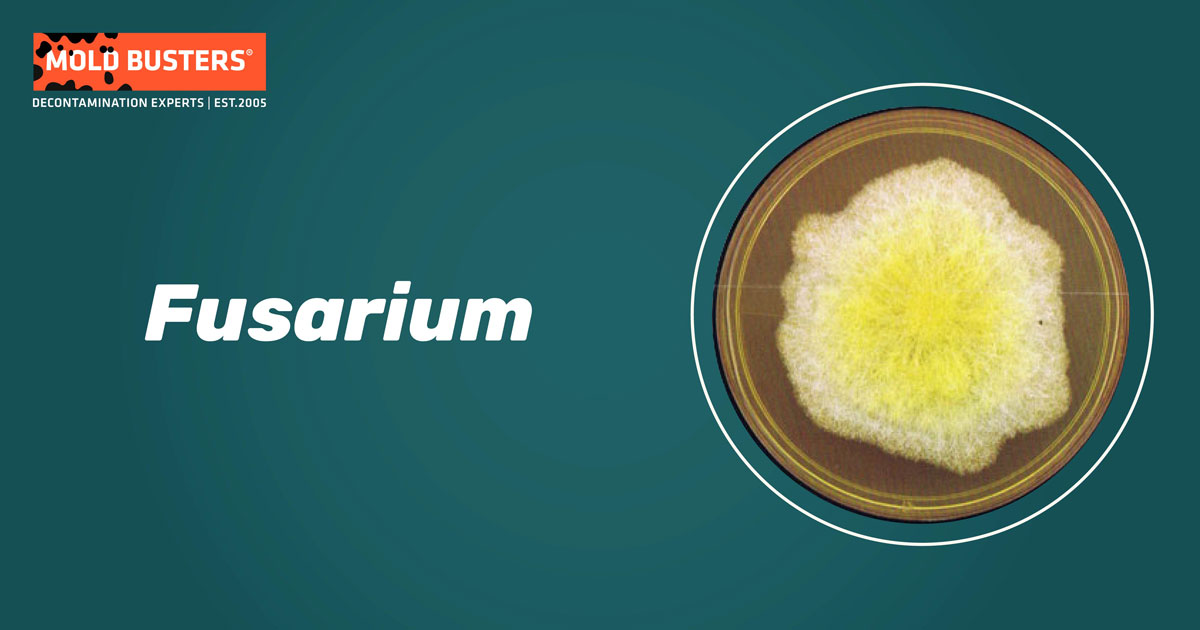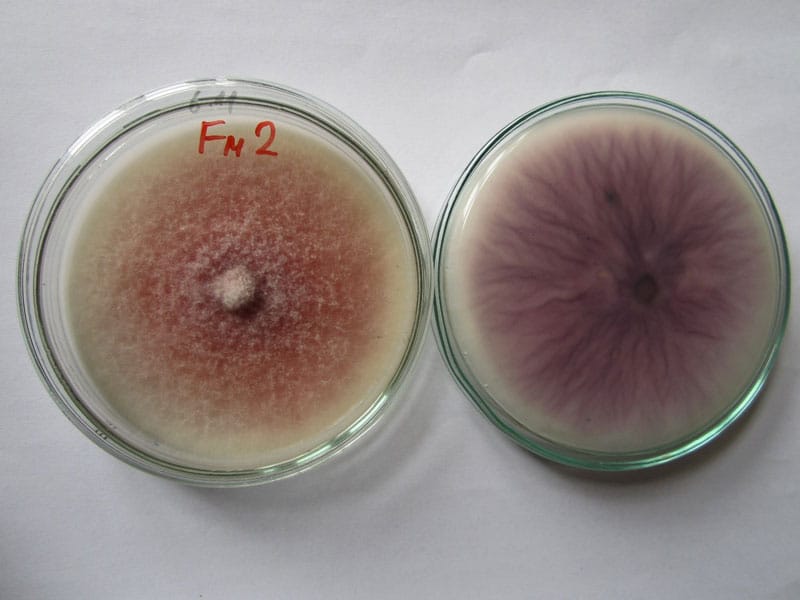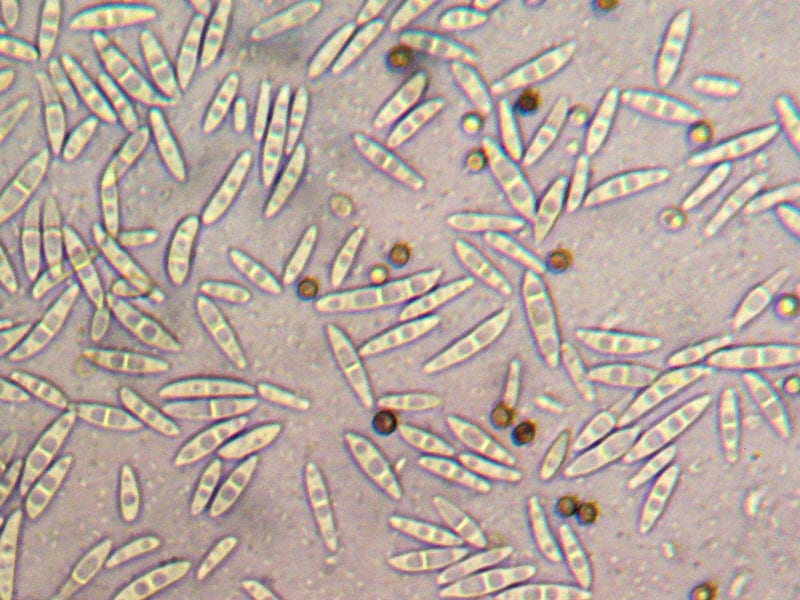What is Fusarium?

Fusarium is a large economically important genus of fungi. It includes numerous species dispersed worldwide. While most of the Fusarium species are harmless saprobes that colonize the soil, some are plant pathogens that can cause significant reductions to crop yields. In addition, several species can cause several human infections.
What are Fusarium species?
There is still no definitive answer as to how many species are included in the Fusarium genus. The taxonomy of the Fusarium genus has changed many times throughout history. The genus was originally described in 1809, with over 1000 species attributed to it over the next 100 years. However, during the 20th century, many researchers sought to organize the genus into sections, subgenera, species, and varieties. According to various taxonomic systems, the genus had anywhere from nine to ninety species. Today, over seventy species are recognized, while some molecular data suggests the true number of Fusarium species to be over 300 [1].
One of the most prevalent species in North America is Fusarium graminearum, which impacts wheat, barley, and maize. It causes a variety of diseases, most notably Fusarium head blight, which has been known to cause billions of dollars of agricultural losses [2]. Fusarium has also industrial applications. F. venenatum, is used in the production of Quorn, a vegan meat substitute.
What does Fusarium look like?
Fusarium spp. forms flat to wooly or cottony colonies, with the color ranging from white, tan, and salmon to cinnamon, yellow, red-violet, pink, or purple (Fig. 1). The most characteristic trait of the Fusarium genus is the formation of macroconidia (Fig. 2). These spores are septate, fusiform to crescent-shaped, and with a foot-shaped basal cell and a less beaked apical cell. Some Fusarium species also produce smaller one to two-celled microconidia, in various shapes.


Where can Fusarium mold be found?
Fusarium spp. thrive in a damp environment, so this mold can develop in any space with increased humidity. Spaces such as bathrooms, kitchens, and basements have the perfect growing conditions. Fusarium molds reproduce by dispersing airborne spores. If these spores land on a cellulose-rich substrate in an environment with favorable temperature and humidity, they will germinate and eventually form mold colonies.
What is Fusarium disease?
Fusarium causes millions of dollars in damage to the United States and Canada annually. These fungi cause a wide range of plant diseases, including crown rot, head blight, and scab. Although best known for occurring on wheat and maize, Fusarium species can grow on all small grain crops, as well as other crops such as asparagus, figs, legumes, soybean, spice plants, and nuts. It can affect roots, fruits, seeds, or leaves. Fusarium mold can be isolated from practically any plant, often as symptomless endophytes.
A strain of F. oxysporum almost decimated the commercial banana industry, during the last century [3]. At the beginning of the 20th century, this fungal disease reached Central America, which held the majority of the global banana production. Known as the Panama Disease, it destroyed over 40.000 ha of banana plantations and the global banana production almost collapsed. At the time, the “Gros Michele” was the most popular variety of bananas, so a new, less susceptible variety had to be found – Cavendish banana. This variety makes up more than 90% of all bananas sold today, and because the bananas are reproduced vegetatively (by cloning) if another particularly aggressive strain of F. oxysporum emerges, it could seriously damage this industry.
How does Fusarium mold impact humans?
Although they are ubiquitous in our surroundings, Fusarium molds will rarely infect healthy individuals. However, sensitive individuals may develop serious health problems when exposed to this mold for prolonged periods.
Fusarium is a known allergen. Inhalation of its spores can cause sinusitis even in immunocompetent individuals [4]. Symptoms of Fusarium allergy are similar to those of other mold allergies.
Furthermore, a wide variety of diseases have been reported in connection to the Fusarium fungi. These include localized infections of the skin and nails (onychomycosis) and eye infections (keratomycosis), which commonly affect people wearing contact lenses. More seriously, Fusarium infection can result in sinusitis, pneumonia, thrombophlebitis, endophthalmitis, septic arthritis, and osteomyelitis [5].
Fusarium infection can be fatal to individuals with weak immune systems. These are mostly people suffering from illnesses such as cancer, HIV/AIDS, or people that have undergone organ transplantation. The lack of an immune response means the infection is easily disseminated. A study found a 90-day mortality rate of cancer patients diagnosed with fusariosis to be near 80% [6].
Another way Fusarium species can affect human health is through the mycotoxins that they produce. The most notable are trichothecenes and the fumonisins. Fumonisins cause fatal livestock diseases and are considered potentially carcinogenic for humans, while trichothecenes are potent inhibitors of protein synthesis [1].
How to know if you have Fusarium mold in your home?
In most cases, Fusarium presents as a black mold. However, there are various types of black mold many of them more dangerous than Fusarium. The only way to truly identify the mold in question is to call a professional mold remediation service.
Cleaning it off the walls is not going to be enough, because if only a few spores are left behind the problem will appear again. Often there are underlying issues that must be dealt with to make the area unsuitable for mold development. Any Fusarium growth on your property can easily be removed by a mold removal expert.
With over 19 years of experience, Mold Busters have a proven track record in the remediation business. Our technicians use the latest in mold remediation technology to inspect and remove mold and can advise you on the steps you need to take to never share your home with mold again. Contact us today to find out more.

Did you know?
Stachybotrys is the 2nd common toxic mold type found in homes we tested?! Find out more exciting mold stats and facts on our mold statistics page.
References
- Munkvold GP (2017). Fusarium Species and Their Associated Mycotoxins. Methods Mol Biol. 1542:51-106.
- McMullen M, Jones R, Gallenberg D (1997). Scab of Wheat and Barley: A Re-emerging Disease of Devastating Impact. Plant Dis. 81(12):1340-1348.
- Ploetz RC (1990). Fusarium Wilt of Banana. APS Press, St. Paul, Minnesota.
- Wickern GM (1993). Fusarium allergic fungal sinusitis. J Allergy Clin Immunol. 92(4):624-5.
- Nucci M, Anaissie E (2007). Fusarium infections in immunocompromised patients. Clin Microbiol Rev. 20(4):695–704.
- Nucci M, Anaissie EJ, Queiroz-Telles F, Martins CA, Trabasso P, Solza C, Mangini C, Simões BP, Colombo AL, Vaz J, Levy CE, Costa S, Moreira VA, Oliveira JS, Paraguay N, Duboc G, Voltarelli JC, Maiolino A, Pasquini R, Souza CA (2003). Outcome predictors of 84 patients with hematologic malignancies and Fusarium infection. Cancer. 98(2):315-9.

Get Special Gift: Industry-Standard Mold Removal Guidelines
Download the industry-standard guidelines that Mold Busters use in their own mold removal services, including news, tips and special offers:

Written by:
John Ward
Account Executive
Mold Busters
Edited by:
Dusan Sadikovic
Mycologist – MSc, PhD
Mold Busters
